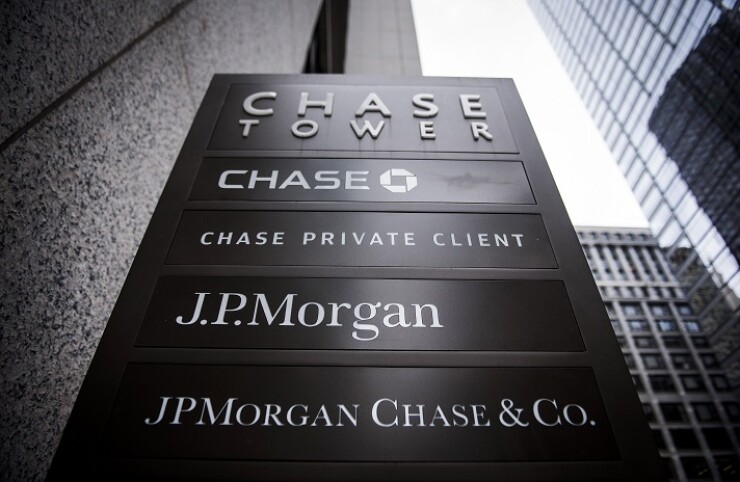The battle between passive and active fund managers is raging in most corners of the investing world. Now it’s coming to the $3.9 trillion municipal bond market with two new actively managed ETFs.
JPMorgan Chase, which has $65 billion in muni investment assets, started two municipal bond ETFs in October that have attracted a combined $50 million in assets. Using active strategies, the funds can select bonds to avoid credit issues and won’t “blindly invest” through indexes tracking what’s often considered an opaque market, said Richard Taormina, a portfolio manager at JPMorgan Asset Management and head of tax aware strategies.
“Active is really the only way to go” when investing in municipal debt, Taormina said. “Passive provides you access, but it doesn’t provide you opportunity.”
The problem is investors aren’t listening. At least not yet.

Actively managed muni ETFs have only attracted $1.3 billion in assets, which pales in comparison to the $32 billion held by passively managed funds tracking state and local debt. The two largest ETF issuers — BlackRock and Vanguard — both run passive muni ETFs and hold more than 63% of the assets.
Fixed income is seen as the next frontier for actively managed ETFs, which are smaller than their passive cousins, but growing. It’s clearly coming to a head in state and local debt, where 13 of the 16 muni ETFs launched since the start of 2017 have been actively managed.
Jillian DelSignore, head of ETF distribution at JPMorgan Asset Management, sees lots of potential for room to develop muni ETFs because of the demand.
“We’re being told that investors are looking to active in fixed-income,” she said. “However, the options for them in the ETF vehicle are very, very small and a fraction of the passive space.”
Other municipal-bond shops have made bets on actively managed products. American Century Investments, known for its muni mutual funds, launched its first actively managed ETF in September.
-
The activity began last Friday when 6.4 million shares hit the tape, fueling a record daily inflow for the fund.
July 29 -
The new data will allow retail investors to better compare active and passive funds.
April 5 -
Asset managers are seeking alternatives to standard mutual fund products.
May 6
Patrick Luby, municipal strategist at CreditSights, said for actively managed vehicles to really catch on investors and advisers need to be educated about the products. Passive muni ETFs have been around longer and offer straightforward access to the debt, he said.
“It’s like the easy button,” Luby said. “If somebody isn’t tremendously conversant in the bond market or munis, but they know they need some exposure, picking an index you want to have exposure to, it’s kind of the easy button.”
MacKay Municipal Managers, which has two muni ETFs, also favors actively managed strategies, said co-head Robert DiMella.
“It is a marketplace that is rife for active strategies — it’s inefficient, it’s fragmented, it’s retail-dominated,” he said. “You do not want to choreograph what you do — index ETFs choreograph what they do.”
Illinois, the state with the lowest credit rating in the U.S., is one of the top holdings of BlackRock’s $9.8 billion iShares National Muni Bond ETF (MUB), which tracks an index of investment-grade municipal debt. It also has a high exposure to California, which investors complain has gotten too expensive.
The good times in munis aren’t likely to last as the Fed’s push to boost interest rates will hamper future results, an expert says.
Additionally, while large indexed funds like MUB are cheap — it charges an annual fee of just 70 cents for every $1,000 invested — the returns typically can’t compete with actively managed national municipal-bond mutual funds, DiMella said.
“You can turn around and tell an investor, ‘Yeah, but what if you can garner an additional 50 or 100 basis points per year if you think of it actively?’” DiMella said. “That is a huge difference in an asset class where most clients and advisers don’t think of active strategies.”
The JPMorgan Municipal ETF (JMUB) is charging $2.40 for every $1,000 invested and the JPMorgan Ultra-Short Municipal ETF (JMST) has a fee of $1.80.
The ultra-short duration fund will allow investors to take advantage of higher yields on the short end with little term risk, Taormina said.
“Two years ago, there was no yield, so why step out and pick up a basis point?” he said. “Now we’ve had a Fed that’s fully engaged, we’ve gone through money market reform. We’re seeing an advantage there.”
Meanwhile, JMUB allows investors to buy for “any cycle,” Taormina said. It can invest up to 10% of its holdings in junk bonds, according to the prospectus. The firm’s portfolio managers and analysts will constantly be “scrubbing” credits that the funds invest in, Taormina added.
“We’re at, or close, to the top of the cycle,” he said. “We want our investors to have that credit lens and not just blindly invest.”






